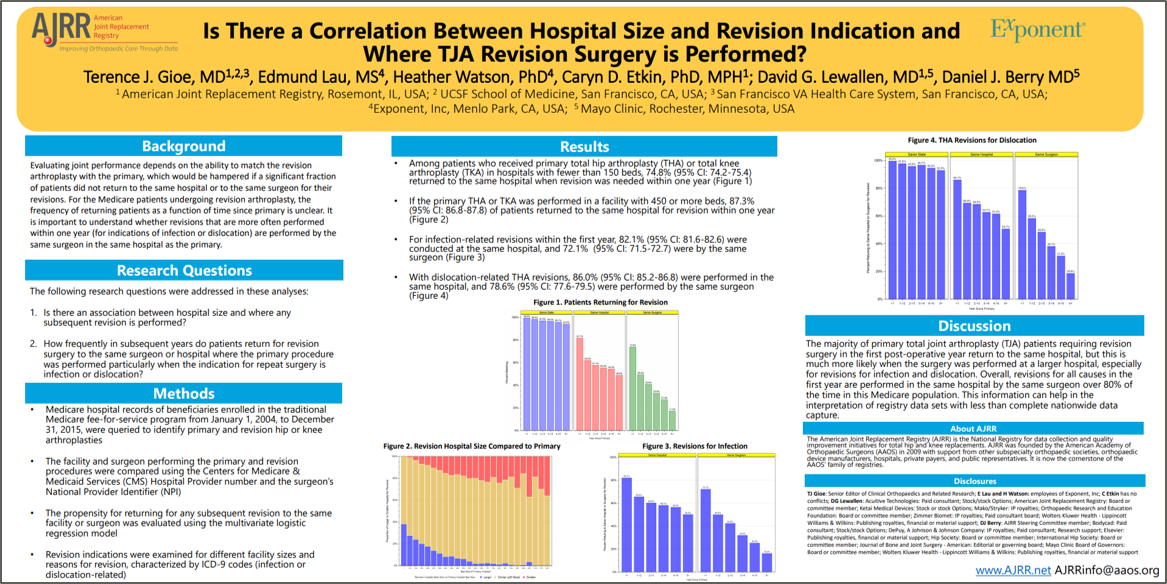The American Joint Replacement Registry (AJRR), the largest hip and knee replacement registry worldwide, conducted a study analyzing the correlation between hospital size, the reason for revision (or re-do) surgery, and the hospital where the total joint arthroplasty (TJA) revision surgery is performed. The link between these three factors has not been studied extensively until now. A poster on the study's findings was presented at the 2018 American Academy of Orthopaedic Surgeons (AAOS) Annual Meeting in March. The poster, titled, "Is There a Correlation Between Hospital Size and Revision Indication and Where TJA Revision Surgery is Performed?" can be seen above.
Hypothesis and Methodology
Medicare hospital claims data and beneficiary enrollment data were used for the study. Medicare patients undergoing a TJA revision can sometimes have it performed by a different surgeon or at a different hospital than the primary (or initial) procedure. The study looks at whether there is an association between hospital size and where the revision is performed, and how frequently Medicare patients return to the same hospital or surgeon in the first year for joint infection or dislocation.
"Data on revision rates that depend exclusively on information from the same hospitals where the primary procedures are performed will under report the actual revision rates occurring," said Terence J. Gioe, MD, lead study author, American Joint Replacement Registry, University of California, San Francisco (UCSF) School of Medicine, San Francisco Veteran Affairs (VA) Health Care System.
Patient Migration Findings Suggest Hospital Size Matters
Patients are less likely to visit another hospital for revision if the primary arthroplasty was performed at a large hospital with 450 or more beds, as compared with smaller hospitals with fewer than 150 beds.
- In hospitals with less than 150 beds, about 76% of revisions within one year were performed at the same hospital. This increases with hospital size.
- In hospitals with over 450 beds, about 88% of revisions were performed at the same institution.
- For infection-related revisions within the first year, about 83% were at the same hospital, and about 80% were by the same surgeon.
- With dislocation-related total hip arthroplasty (THA) revisions, about 87% were performed in the same hospital, and about 83% were performed by the same surgeon.
- For every additional year after the primary arthroplasty, the likelihood of attending another hospital for revision increased by 9%.
"Although this study looked at Medicare data as opposed to AJRR data, the findings will inform future Registry research projects and will lay the groundwork as the AJRR becomes more diverse and comprehensive," said AJRR Director of Analytics Caryn D. Etkin, PhD, MPH. "It will be interesting to share the results of the study with our international counterparts, and to see if similar trends have occurred on the global scale."
How This Study Informs Future Revision Research Efforts
The magnitude and characteristics of patient migration following TJA have not previously been studied in the US. Loss to follow-up due to patient migration will be a key potential limitation of large-scale studies on implant performance in the US.
"Assessment of loss to follow-up can provide an essential understanding of the migration patterns of TJA patients. This understanding is essential as hospitals seek nationwide data to scientifically support TJA assessment. It will certainly help to improve recruitment and enrollment efforts of AJRR, as hospitals continue to recognize the growing national reach of the Registry," concluded Dr. Gioe.
For information about AJRR's RegistryInsights™ platform, speak with a Business Development Representative at (847) 292-0530 or Request A Demo today!
Be sure to leave a comment in the form below!


